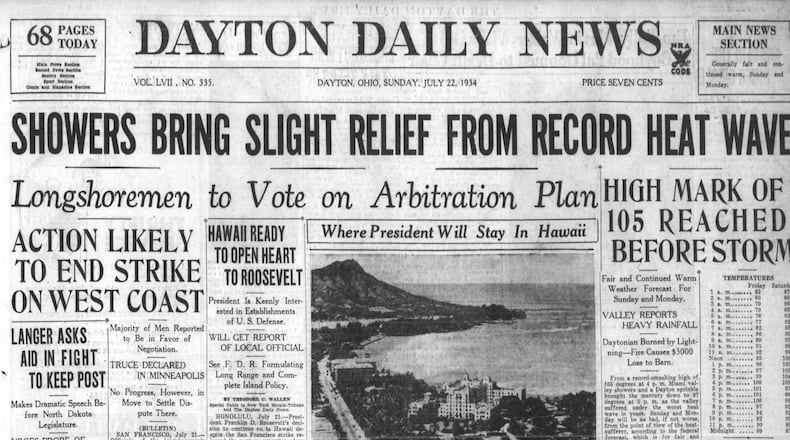Many people were forced to stay inside during the day and sleep outside at night to find relief from the scorching temperatures.
Dayton feels the heat
The unprecedented heat bore down on Dayton starting on July 19 and reached its peak on Saturday, July 21. Mercury hit the 100-degree mark by noon and was up to 103 by 1 p.m. The low temperature reading for the day was 82 degrees at 6 a.m.
According to the Sunday, July 22, 1934 Dayton Daily News, the day prior was “a record-smashing 105 degrees at 4 p.m."
The hottest temperature in the period was 105 degrees.
Daytonians resorted to many different ways to keep cool. Friday and Friday night, thousands slept outdoors.
The Miami River at the Main Street bridge set a new low stage record on July 24 of .03 inches. The river, of course, was deeper in other places.
Residents in and near Centerville faced water shortages. At the time, the village was served entirely by wells, which had all dried up. The small streams and springs on which residents depended on for their water supply were also dry.
Rain relief
On Sunday, July 22, a quick but powerful storm rolled through Dayton.
The storm that hit that day was a bad one. One man was hit by lightning, and a barn was also hit and burned in Pleasant Hill. Wind blew down a number of trees and took down the power lines in Piqua.
Then after a rain shower, the temperature dropped to 97 degrees, but then again started to rise.
Finally a break
Relief from the heat finally came on Thursday and Friday of that week as light breezes and clouds preceded a band of rain showers.
By Friday, Daytonians were finally starting to relax, as temperatures began to drop.
The heatwave, which started on July 19, was broken after eight days. Temperatures were recorded at least in the 90s each day during that stretch. Reading of 100 degrees or higher were noted in July 21, 22, 23, 24, 25 and 26.
By the end, 16 heat-related deaths had been reported in Dayton.
The damage to crops from the heat could not be estimated, but crop experts reported that corn crops in the area were badly burned by the dry heat.
Elsewhere in Ohio
Ohio’s hottest temperature was recorded by a weather station four miles northwest of Gallipolis at 113 degrees on July 21, 1934.
Many heat records were set throughout the state, including 111 degrees in Wilmington, Defiance and Hamilton; 110 at Fremont; 109 at Cincinnati, Findlay and Chillicothe; 108 at Delaware; 107 at Bowling Green; and 106 in Columbus.
Estimates show the death toll in Ohio at 160 dead just during the week of July 20-26.
About the Author







